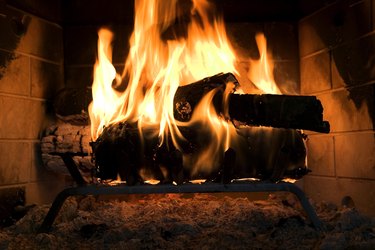
Fireplace heat reflectors will maximize gas and wood use, and protect your firebox from heat damage. Brick and mortar fireplaces are susceptible to the constant heating and cooling from fires. Bricks and mortar will shrink and crack over time. Using a heat reflector will reduce the amount of heat reaching the back wall of a fireplace by as much as one-third, which can mean less damage over time. And, fewer repairs as well, which can be very costly. Fireplace heat reflectors will also increase the amount of heat entering the room by as much as 42 percent.
Step 1
Measure the back wall of your fireplace in inches, as well as the grate. The heat reflector is made from non-combustible metal and has "feet" that it stands on. You will need to make sure that your grate will fit either over or in between the feet.
Video of the Day
Step 2
Buy the appropriate size heat reflector for your fireplace.
Step 3
Remove your fire grate, and install your fireplace heat reflector into the back of a clean firebox, following the manufacturer's directions. Make sure that it sits flat and is stable.
Step 4
Replace the grate, and use your fireplace as you normally would.
Tip
Your local hardware store or home improvement center should carry heat reflectors. If not, contact a chimney sweep. Most of them will be able to order one for you. A sweep will also measure and install for you on request.
Video of the Day